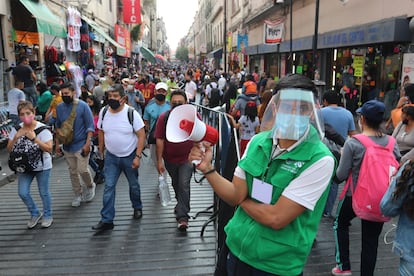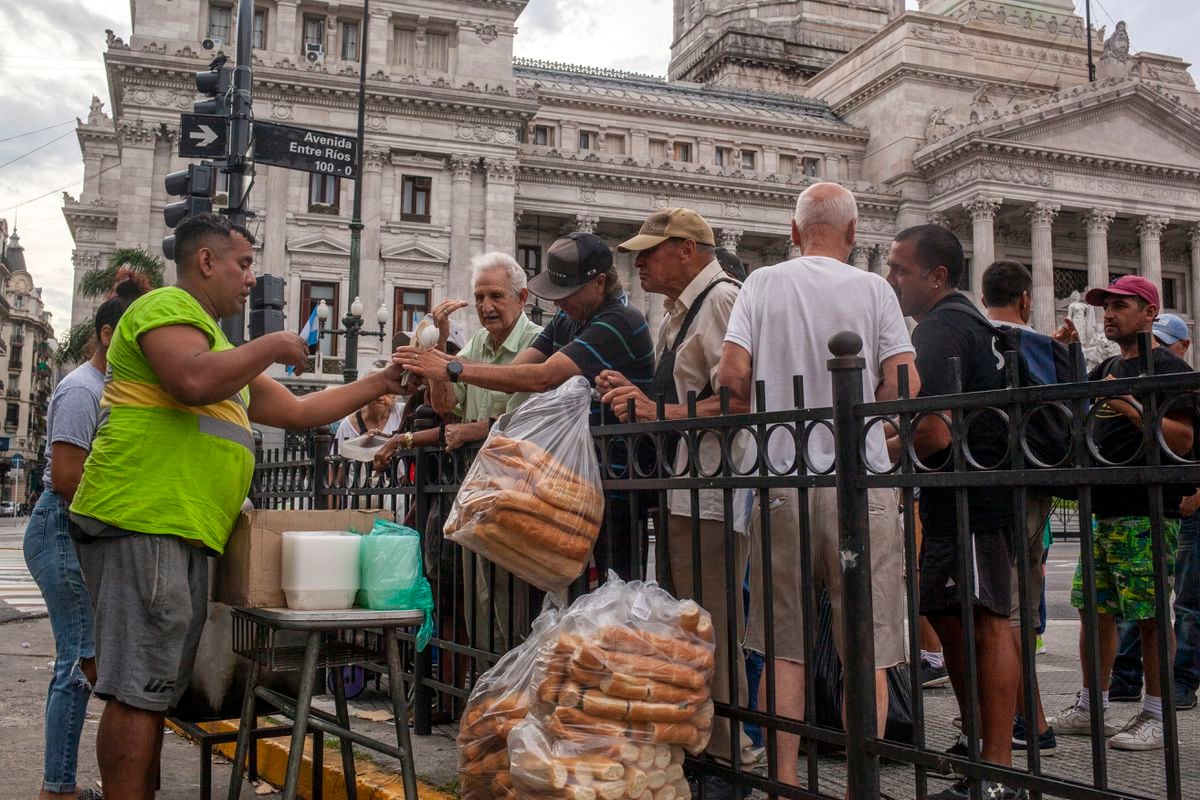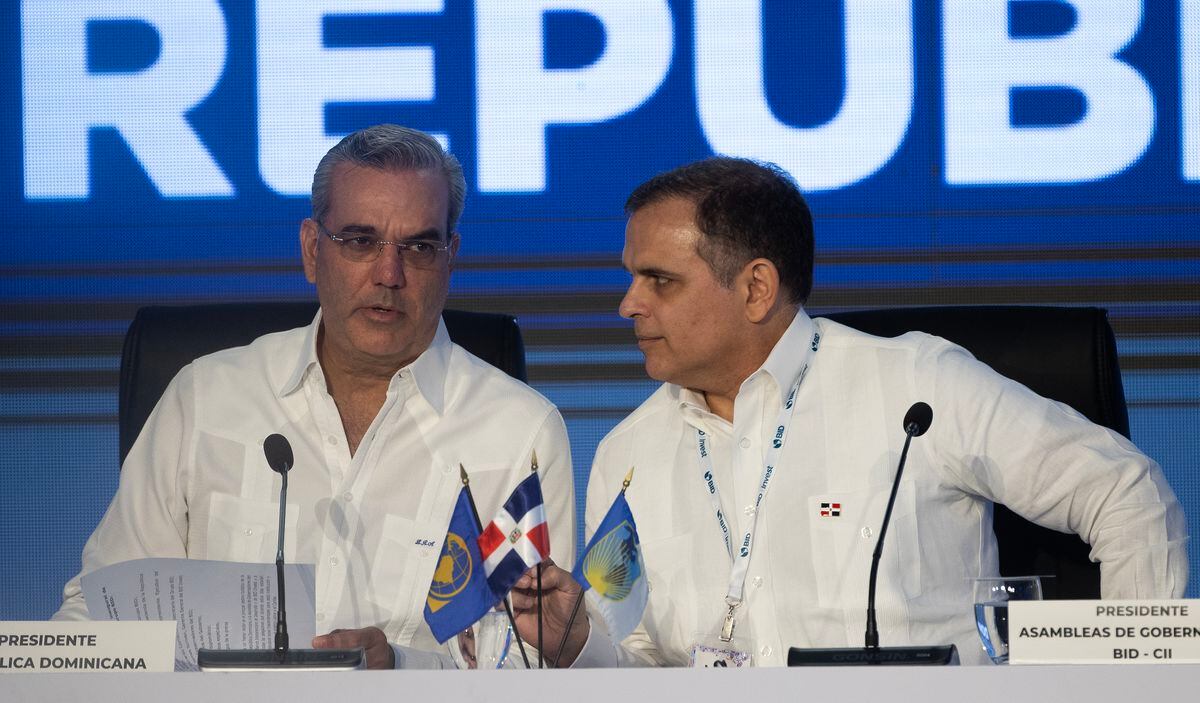An official promotes social distancing in a busy commercial street in the historic center of Mexico City.José Pazos / EFE
Despite the enormous ravages of the coronavirus pandemic, the economic recovery of Latin America and the Caribbean this 2021 will be better than expected, according to the perspectives published this Tuesday by the International Monetary Fund (IMF). The region's economy will grow 5.8% this year, according to its new update, an improvement of 1.2 percentage points compared to the April estimate. The rebound will be somewhat slower next year, according to the Washington-based body, which projects regional growth of 3.2% in 2022.
The improvement in forecasts for Latin America and the Caribbean is mainly due to upward revisions for Brazil and Mexico, the two large neighborhood economies, the IMF report notes.
The South American giant will grow 5.3% this year and the next 1.9%, while the North American country aims at 6.3% in 2021 and 4.2% in 2022. These figures largely reflect a stronger performance than anticipated in the first quarter, the favorable effects for Mexico as a result of the improvement in the outlook for the United States (7% in 2021 and 4.9% in 2022) and a boom in commercial exchange for Brazil, according to experts from the Background.
More information
The IMF urges rich countries to contribute 41,000 million to accelerate vaccination in the rest of the world
Colombia proposes raising taxes on companies as a temporary solution after the failure of the tax reform
The world economy as a whole will grow 6% in 2021, the same figure of April, but the perspectives now diverge even more between the different countries since then, warns the multilateral, which has already pointed out in its previous reports the challenges posed by these notable divergences in the speed of recovery.
For 2022, the forecast improves half a percentage point to 4.9%.
Huge fiscal stimulus and improved health indicators in developed economies are driving a somewhat faster recovery there than anticipated, particularly in the United States, in contrast to other places.
The biggest victims are emerging Asian countries.
Prospects depend on the trajectory of the pandemic, and access to vaccines has emerged as the main breaking point at which the global recovery is divided into two blocks: “those who can anticipate further normalization of activity by the end of this year (almost all advanced economies) and those that will still face outbreaks of infections and deaths from covid on the rise, ”the document says. The IMF warns, however, that recovery "is not assured even in countries where infections are currently very low" as long as the virus circulates in other places, because if immunization campaigns are slowed down that will allow new mutations that in turn They can sometimes put global forecasts at risk.
The idea that no one will be safe until everyone is vaccinated, even in the remotest reaches, has plagued the length of the pandemic, and the IMF itself has already urged rich countries to make contributions to speed up vaccination elsewhere. of the world. The agency's roadmap proposes the double objective that 40% of the world's population is immunized before the end of 2021 and that 60% will be immunized by mid-2022. To achieve this, the technicians estimate that 50,000 are needed million dollars (41,000 million euros).
“Multilateral action has a key role to play in reducing divergences and strengthening global prospects. The immediate priority is to deploy vaccines equitably around the world, ”the document concludes. "Economies with financial constraints also need unhindered access to international liquidity," he says. "Concerted and well-targeted policies can make the difference between a future of long-lasting recoveries for all economies or one with ever-widening cracks."
The multilateral organization also expects raw material prices to rise faster than its previous forecasts. In the midst of the recovery, the price of oil, in particular, will rise in 2021 about 60% from the lowest price in 2020, according to its projections. It also expects non-oil commodity prices to rise about 30% from 2020 levels, with particularly strong increases in metal and food prices.
"Fiscal policy should continue to prioritize health spending, including vaccine production and distribution infrastructure, personnel, and public health campaigns to drive acceptance," the IMF recommends, while acknowledging that the fiscal policy space for Achieving these purposes varies from country to country. In emerging market and developing economies with more limited fiscal space, redirecting spending from untargeted subsidies and recurring expenditures toward health, social and infrastructure outlays can help create some of the needed space, experts say. . However, many countries will need strong international support.
Subscribe here
to the
EL PAÍS América
newsletter
and receive all the information keys on the region's current affairs


/cloudfront-eu-central-1.images.arcpublishing.com/prisa/2C5HI6YHNFHDLJSBNWHOIAS2AE.jpeg)

/cloudfront-eu-central-1.images.arcpublishing.com/prisa/2KVLLY26ZNGK3OCBRI676KYGKA.jpg)


/cloudfront-eu-central-1.images.arcpublishing.com/prisa/D6BPFYE4B5FMJAMYWLMWT3HYGQ.jpg)
/cloudfront-eu-central-1.images.arcpublishing.com/prisa/MYQ5IMFXJZF4NGVYA5PCRZJJCM.JPG)
